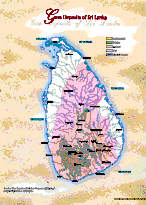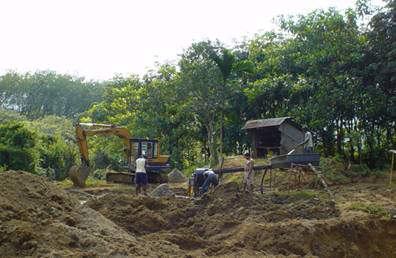The history of the gems of Sri Lanka can be traced back some 3,000 years or so. They are part of many legends, folk lore and literary works. Sri Lankas gems are much written about by early travellers from Europe, Arabia and Asia. They have adorned many a Crown, Sceptre and Throne. These gems are the prized possessions of royalty and the rich and famous through the ages right up to this day.
Out of about 200 minerals that are classified as gemstones, around 75 varieties are found in Sri Lanka, making this small island one of the most important geographic locations in the world of gemstones
Corundum and Chrysoberyl are the two most commercially important species of gemstones found in Sri Lanka. Sri Lanka is particularly renowned for its blue sapphires, star sapphires and star rubies and the pathmaraga (padparadscha) sapphires.
The gem and jewellery industry has been an important part of Sri Lankas economy for well over two centuries and remains so even today, and is likely to remain so into the foreseeable future.
About 70% of Sri Lankas land mass could be considered as potentially gem bearing, as seen in the prospectors map compiled by Prof. C. B. Dissanayake.
The majority of economic activity in the industry falls within 3 main sectors, mining, manufacturing and trading.
The total employment in the industry is estimated at close to 300,000, the break up of which shown in the following table.
| Industry Employment | |
| Sub Sector | Number |
| Mining | 105,000 |
| Manufacturing | 100,000 |
| Trading | 85,000 |
The value chain of the modern day gem and jewellery industry in Sri Lanka is depicted in the following diagram.



About 90% of the gem mining is carried out in alluvial deposits using traditional methods, in open cast shallow pits or deeper shaft type pits and tunnels or by manually dredging the river beds. A gradual rise in the use of light mechanized mining methods can also be seen in recent times.
Gem mining activities are concentrated mainly in the Districts of Ratnapura, Matale, Badulla and Moneragala
The primary manufacturing activities are gem cutting (lapidary) and jewellery manufacture. The lapidary sub-sector consists of the diamond manufacturing industry and cutting and polishing of coloured gemstones. The sub-sector for jewellery manufacture consists mostly of traditional artisanal production units but modern mass manufacture is also on the rise. It is estimated that there are around 3,000 manufacturing units around the country.
There are four main trading oriented activities which are gem dealing (wholesale), importing, exporting and retailing
The total value of the gem & jewellery trade at export and retail points is estimated at about Rs. 55 billion (USD 550 million) annually. The market for gems and jewellery in Sri Lanka can be divided into 3 major market segments as shown in the table below.
| Market Segment | Value(Rs. Billions) | Share(%) |
| Domestic | 17.5 | 31% |
| Tourist | 2.7 | 5% |
| Export | 35.5 | 64% |
| Total | 55.7 | 100% |
The largest market segment in value terms is the export market which is made of four main product categories, namely Geuda (refers to an unprocessed variety of corundum), Polished Diamonds, Cut & Polished Gemstones and Jewellery.
Though diamond exports account for most the export value, the value addition in this sub-sector remains low. The gem sub-sector accounts for most of the value addition

Exports have continued to grow steadily over the past few years as can be seen in the chart.
The Domestic jewellery market is the second biggest market segment and refers to the sale of jewellery to domestic consumers. The main demand from this market segment is for traditional jewellery made with 22 karat gold.
The third segment is the tourist market which refers to the sale of gems & jewellery to the 500,000 + tourists that visit Sri Lanka each year. Though available statistics put the value of this market segment at around Rs. 2.7 billion, industry experts estimate that the correct value is at least double this. This segment is very significant in terms of high levels of value addition.
In the context of the Sri Lankan economy, the gem and jewellery industry has and will continue to be one of the most important industries in the country both as a vitally important source of foreign exchange earning and employment generation.
In a global context, this Island of Gems (an ancient name for Sri Lanka was Ratnadvipa which means Island of Gems) continues to be one of the most important, if not the most important source of fine sapphires in the world. Arguably no other source has produced sapphires in size, quantity and quality for as long a time as Sri Lanka has.
Among the connoisseurs of gemstones, Ceylon Sapphire continues to enjoy a good reputation and occupies a unique space as a special gemstone. It is truly the ‘King of Gems’ and the ‘Gem of Kings’ from this Ratnadvipa.
The above article is reproduced with kind permission from the National Gem and Jewellery Authority.You are welcome to discuss this post/related topics with Dr Shihaan and other experts from around the world in our FORUMS (forums.internetstones.com)

Very useful blog with important facts and figures. Thank you